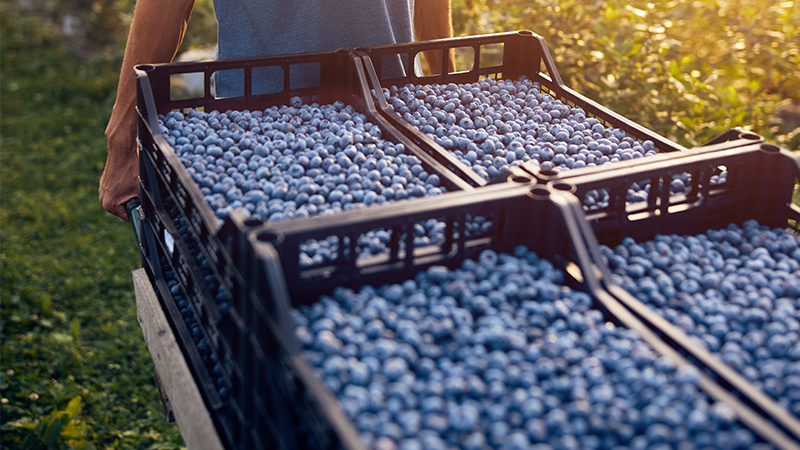Field Scouting Guide: Verticillium Wilt

One way to distinguish Verticillium wilt from other wilts is its V-shaped lesions that extend inward from the margin of the leaf.
Photo by Gerald Holmes
This edition of “Field Scouting Guide” concentrates on Verticillium wilt.
Steven T. Koike, TriCal Diagnostics, and Inga Meadows, North Carolina State University, share information and photos to help you learn more about how to spot and treat this disease.
BASICS
- Scientific name: Verticillium dahlia or V. albo-atrum, both can cause Vertcillium wilt, but V. dahlia is the more common and widely distributed species. There are other Verticillium species, but these are less damaging than V. dahliae.
- Geographical Range: Worldwide and probably in most agricultural areas, including cooler tomato production areas.
- Crops affected: More than 300 woody and herbaceous plants including tomato, eggplant, and potato. It also affects perennial woody crops (fruit, nut, vine), annual vegetable crops, small fruits (strawberry), field crops (cotton), and ornamental plants.
PEST IMPACT
Meadows: This disease is currently a problem on tomato primarily in more temperate areas. Eggplant is also affected and is very susceptible, but the disease may not be well known since the crop is not as common.
The interesting part about this disease is that most hybrid tomato varieties have resistance to Verticillium provided by the Ve gene, but this gene is only resistant to race 1 of the fungus. We know there are strains out there that can overcome the Ve gene, and these strains have become prevalent because by planting varieties with the Ve gene, we’ve selected for strains that overcome resistance. A race is simply a strain of the same species of fungus that can overcome a gene for resistance in the host plant.
I don’t have exact figures on the economic impact of Verticillium wilt. However, if you consider how widespread the disease is in this region, even a 5% reduction in yields, which is probably a conservative estimate, would mean a $2 million reduction in production in North Carolina (based on USDA ag statistics from 2017 in North Carolina). So it’s a significant problem.
Koike: In California, it impacts very serious on a number of vegetables, small fruit, and fruit/nut crops. It is found in all parts of the state (north/south, coastal/inland).
The economic impact is significant. It can kill outright vegetable and small fruit plants. It can also kill young trees (but usually has less impact on larger, mature fruit/nut tree plants).
For most vegetable and small fruit crops, Verticillium symptoms develop later in the crop cycle, when vegetable crops are nearing maturity and small fruit crops begin to produce fruit. Verticillium wilt tends to mostly affect tree fruit/nut crops when trees are young.
IDENTIFICATION
Koike: Because Verticillium wilt causes plugging of the water-carrying tissues (xylem) of the plant, overall symptoms of Verticillium wilt can resemble symptoms caused by under or over irrigation, water stress, nutrient deficiencies, and general stress. In addition, Verticillium wilt closely resembles other diseases such as Fusarium wilt, root rots, and others.
Typical symptoms include:
- External: wilting, yellowing, leaf drop, plant collapse
- Internal: vascular tissue is usually black to dark brown (need to cut into main stem to see this)
- Note: Verticillium wilt is not a root rot disease, so roots will look normal.
The Verticillium pathogen can be seed borne in some crops. As a soilborne pathogen, V. dahliae makes a survival structure (microsclerotium) that can survive in a dormant state in soil for a number of years.
Different races of the pathogen exist. For example, tomato growers suffered from Verticillium wilt losses until resistant cultivars were developed. After these cultivars were used for a while, race 2 of the pathogen developed through mutation or selection. Now the tomato cultivars that were resistant to the disease are once again dying but this time due to the new race 2.
Meadows: Although Verticillium can be mistaken for other wilts, its symptoms are distinctive. It has V-shaped lesions that extend inward from the margin of the leaf. Fusarium wilt will have one-sided wilting and/or yellowing. Bacterial wilt tends to cause the plants to wilt while they are still green — it’s a more sudden wilt — and, if a section of the lower stem is cut just above the soil line and placed in water, you’ll see bacteria stream out of the tissue.
This is a pretty easy diagnostic tool. For Verticillium, though, the wilting symptom may not always be observed, except in the late afternoon when the disease has progressed to a later stage. Given the leaf symptom, some people can mistake it for a foliar disease.
RECOMMENDED TREATMENT
Koike: Managing Verticillium wilt is a good example of an integrated pest management approach. The most effective method of control is to use resistant cultivars if available.
The next best method involves cultural practices: do not plant susceptible crops in known infested fields; rotate to non-host crops and cruciferous crops such as broccoli (bio-fumigation/microbial diversity); practice good sanitation (infested soil on tractors and equipment will spread the pathogen to other fields); reduce stress to the crop, which makes Verticillium wilt more severe — stress factors include environmental extremes/heat and other pests such as nematodes.
The only effective chemistries are pre-plant fumigants such as chloropicrin (used pre-plant in strawberry, some tree/nut crops). No post-plant fungicides or chemical treatments are helpful. No organically acceptable treatments exist. Organic options are crop rotation, avoid planting in infested fields, use resistant cultivars if available, practice field sanitation, reduce stress to crop.
Meadows: Try to use the Ve gene where possible, which will be effective in areas where non-race 1 strains have not built up. A longer crop rotation can help reduce disease, but four to five years away from a susceptible host is required, and growers can’t always do that.
So that leaves soil fumigation. The problem here is that the current fumigants don’t move as well in soil as did methyl bromide, which was phased out. The zone of treated soil is smaller, and the roots tend to grow into that zone and show symptoms of Verticillium wilt later in the season. Chloropicrin is the best soil fumigant for control of Verticillium wilt. It can come as a solo product or can be mixed with other fumigants.
So, maybe yields aren’t hurt as much when disease occurs later in the season. However, when growers don’t fumigate or, worse, they fumigated and soil conditions were not ideal and the fumigants didn’t move as much in the soil, then we can see the disease come in earlier.
This scenario is where we can see more significant yield loss. Especially where the grower can’t rotate away from a susceptible crop for three or four years.
Some breeders are working on incorporating resistance or tolerance to Verticillium. I know Dr. Randy Gardner, Professor Emeritus at North Carolina State, has some germplasm that has shown some tolerance in the field, but I don’t want to speak for him or incorrectly state his findings.
Regardless, the key to this disease will be to first, identify the strains that we have in North Carolina and other tomato production areas, and then develop desirable varieties with durable resistance.










